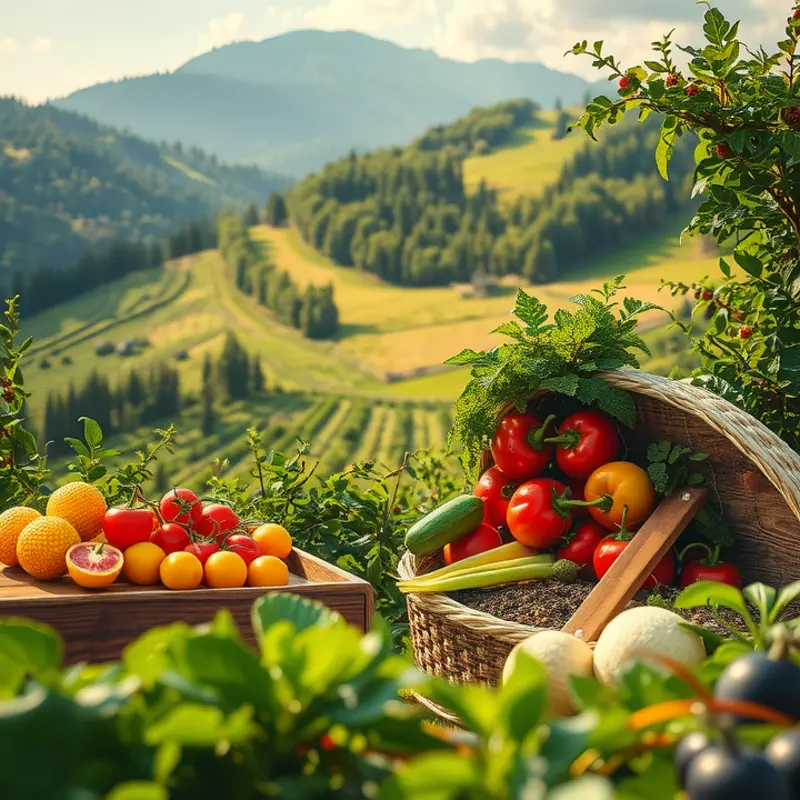Eating with the seasons is a vibrant way to boost your health while enjoying a variety of tasty foods. Seasonal produce is not only fresher and tastier, but it also retains more nutrients and is often more affordable. By incorporating seasonal fruits and vegetables into your meals, you can enhance your nutrition and cultivate a deeper connection to the food you eat. Let’s dive into the benefits of seasonal eating and discover which fruits and vegetables are at their peak throughout the year.
Why Eat Seasonally? The Benefits for Health and Community

Eating seasonally offers various benefits, enhancing personal health and supporting local ecosystems. The nutritional advantages of consuming seasonal produce are noteworthy. Fruits and vegetables picked at their peak tend to have optimal nutrient content. For example, fresh, ripe tomatoes in summer could provide more vitamin C than those harvested out of season. Consuming foods when they are naturally available ensures you’re getting maximum vitamins, minerals, and antioxidants, crucial for maintaining a balanced diet.
Beyond individual health, seasonal eating reduces environmental impact. Produce that is grown out of season often requires more energy inputs, such as heating or cooling systems for greenhouses, which increase carbon emissions. Furthermore, out-of-season produce typically needs to be transported from far distances, further escalating its carbon footprint. By choosing seasonal options, we minimize the resources used in food production and transportation, contributing to a more sustainable way of living.
Seasonal eating also strengthens local economies and supports farmers in the community. Purchasing local seasonal produce ensures that your money circulates within your community, boosting local markets and encouraging agricultural diversity. Farmers can diversify their crops with the changing seasons, which promotes healthier soil and reduces reliance on monocultures.
Incorporating seasonality into your routine doesn’t have to be difficult. There are resources available to help recognize what’s in season and how to make the most out of these ingredients. For those interested in sustainable practices at home, an eco-friendly guide to smarter kitchen storage can significantly aid in preserving seasonal foods when they are abundant.
Additionally, eating seasonally connects us to the rhythm of nature. It encourages a mindful approach to food, allowing us to savor different flavors and nutrients across seasons. Eating with the seasons invites creativity in the kitchen as well, inspiring recipes that align with the time of year.
Overall, adopting a habitual approach to seasonal eating brings numerous advantages. From leading a healthier lifestyle to supporting ecological balance and local communities, seasonal produce is a key ingredient in a well-rounded, sustainable diet.
Your Seasonal Shopping Guide: Product by Product

Spring emerges with vibrant greenery and a colorful array of fresh produce. Aim for asparagus, peas, radishes, and strawberries. Asparagus bursts with vitamins A, C, and K, boosting immunity and bone health. Lightly steam or grill them to retain nutrients. Store them upright in a glass of water in the fridge to prolong freshness.
Peas provide protein and fiber. Add them to stir-fries or salads for a subtle sweetness. Keep them frozen in airtight containers after blanching to maintain their texture. Radishes, with their peppery flavor, serve as excellent sources of antioxidants. Enjoy them raw for maximum crunch. Store radishes by removing leaves and placing them in a sealed container lined with damp paper towels.
Summer offers bountiful produce like tomatoes, bell peppers, zucchini, and peaches. Tomatoes pack a punch of lycopene, which may reduce cancer risks. Roast them with olive oil to deepen their flavor. Store tomatoes at room temperature to preserve taste. Bell peppers, rich in vitamin C, can be stuffed, grilled, or stir-fried. Keep them in the crisper drawer of your fridge to extend their shelf life.
Zucchini contains fiber and vitamin B6, supporting digestion. Spiralize them into noodles or bake into breads. Store in a plastic bag in the refrigerator. Juicy peaches, loaded with vitamin C and fiber, refresh and satisfy. Enjoy them fresh or in desserts. Keep peaches in a single layer on the counter until ripe, then refrigerate.
Fall delivers rich flavors with produce like pumpkins, squash, apples, and Brussels sprouts. Pumpkins are abundant in beta-carotene, promoting eye health. Roast seeds for a crunchy snack. Store uncut pumpkins in a cool, dark place. Squash, packed with vitamins and minerals, can be roasted or stuffed. Once cut, refrigerate squash pieces in sealed containers.
Apples provide fiber and vitamin C. Perfect for snacking or baking, store them in the crisper for optimum freshness. Brussels sprouts boast a wealth of vitamin K. Roast them for a sweet, nutty flavor. Keep them in a sealed bag in the fridge to maintain crispness.
Winter harvests root vegetables and citrus. Carrots, sweet potatoes, and oranges rule the season. Carrots offer vitamin A, crucial for vision. Use them in soups or raw as snacks. Store them in sand or sawdust in a cool place to prevent sprouting. Sweet potatoes, rich in antioxidants, support gut health and immunity. Roast or mash them for warming dishes. Preserve their condition by storing them in a cool, dry place.
Oranges, packed with vitamin C, elevate immune function. Integrate them into salads or enjoy as fresh juice. Keep oranges at room temperature away from direct sunlight. Learn how functional foods such as these seasonal produce can support cartilage health on this page, and explore more about leveraging seasonal choices for optimal nutrition.
This guide encourages exploring new flavors and expanding your palate. Seasonally shopping connects you with nature, promoting eco-friendly and healthy eating. Remember, each season presents a chance to discover nutritional treasures and culinary interests. Stay aware of produce cycles to maximize flavor and nutrition year-round.
Final words
Adopting a seasonal approach to your diet not only enhances the flavors and nutritional profiles of your meals but also connects you with the cycles of nature. By choosing fruits and vegetables that are in season, you support your local economy, minimize your environmental impact, and diversify your nutrient intake. As you explore the world of seasonal produce, you’ll discover endless possibilities for new recipes and delightful flavors. Embrace the change of seasons and enjoy the abundance of nature’s offerings!







